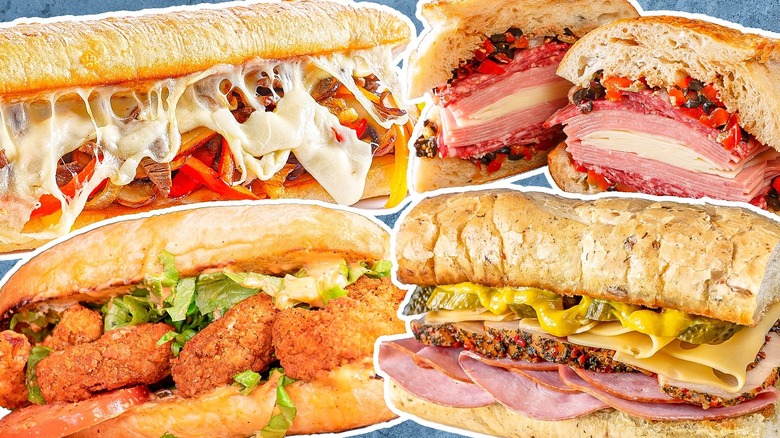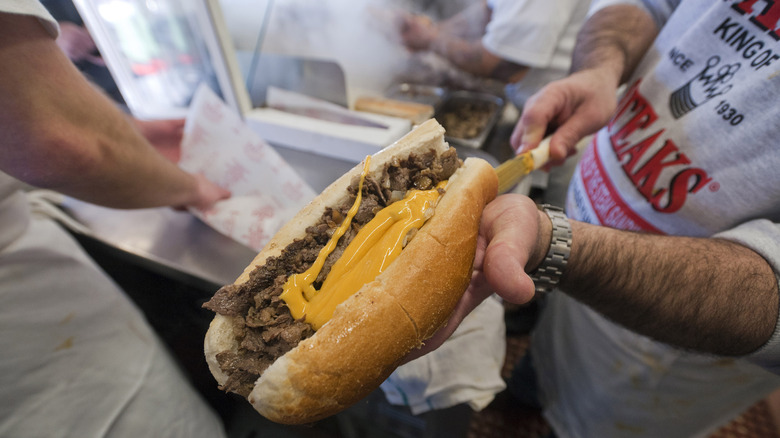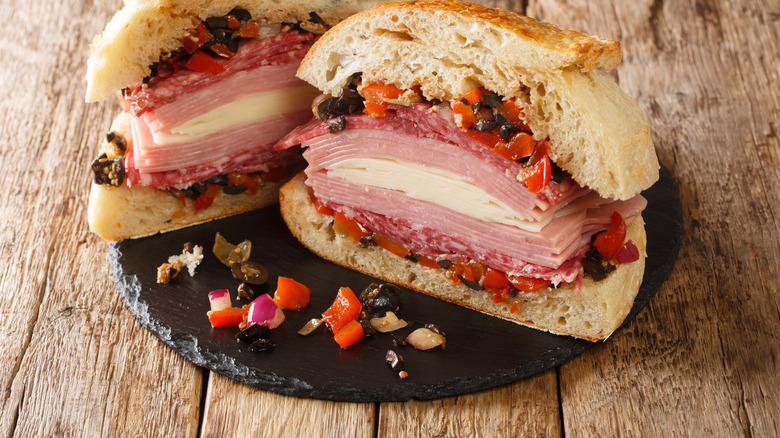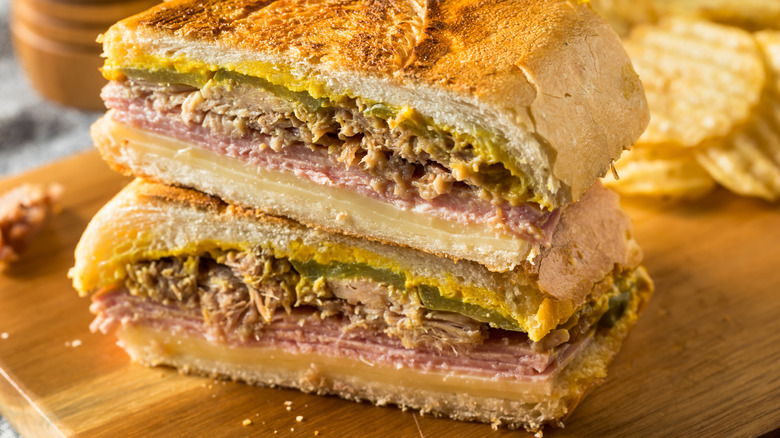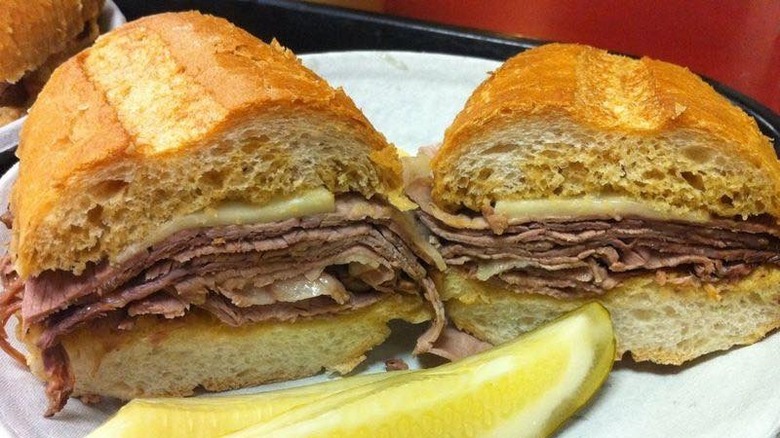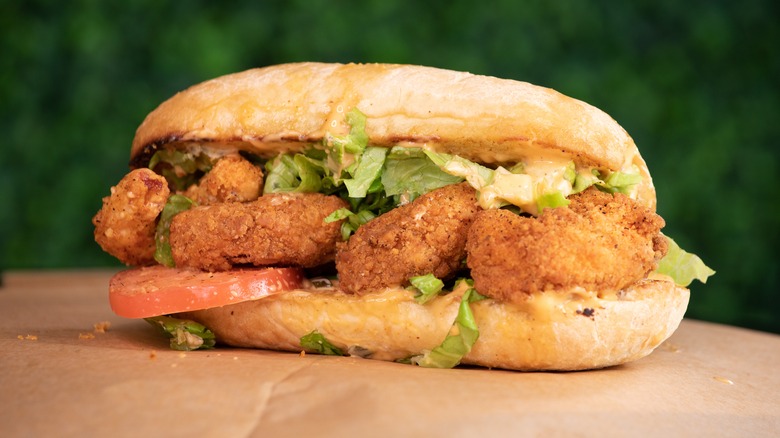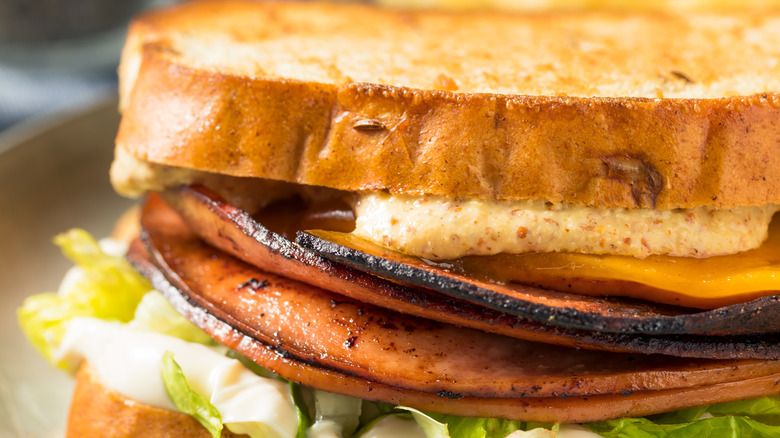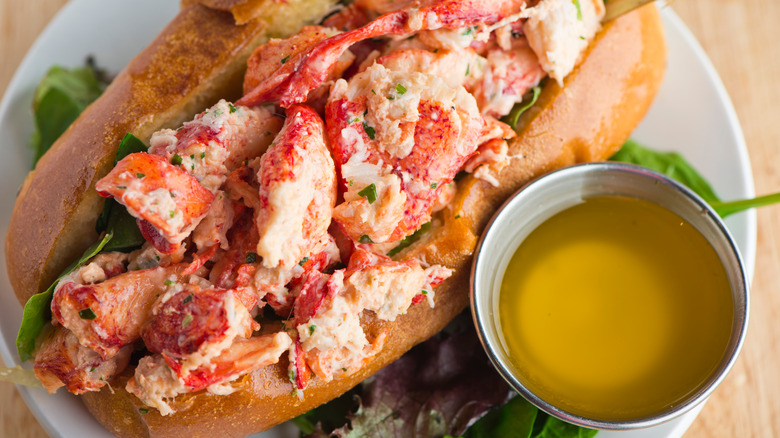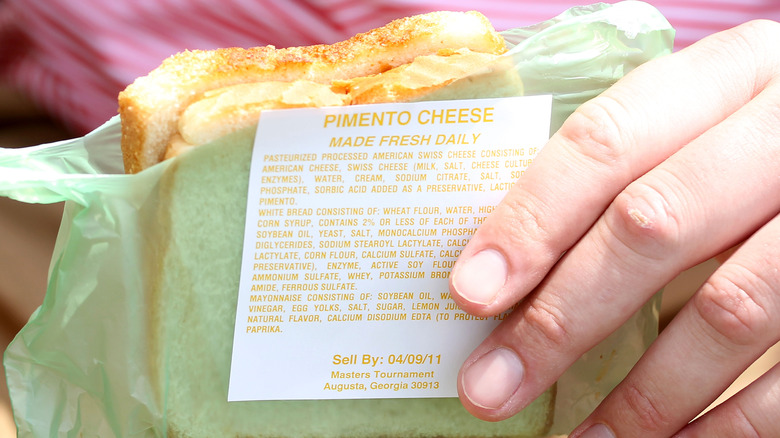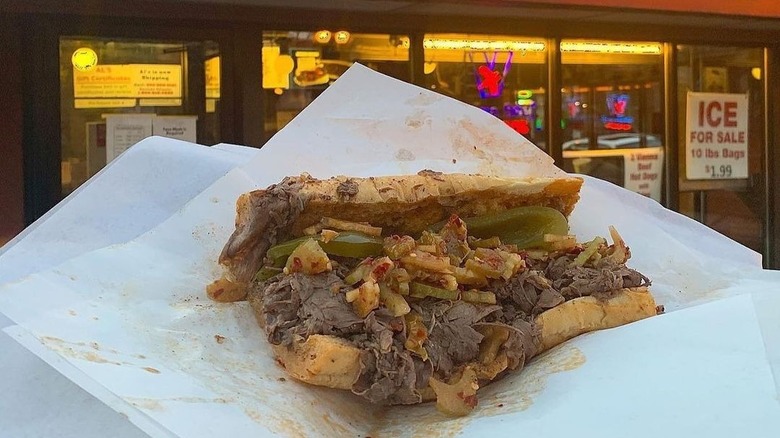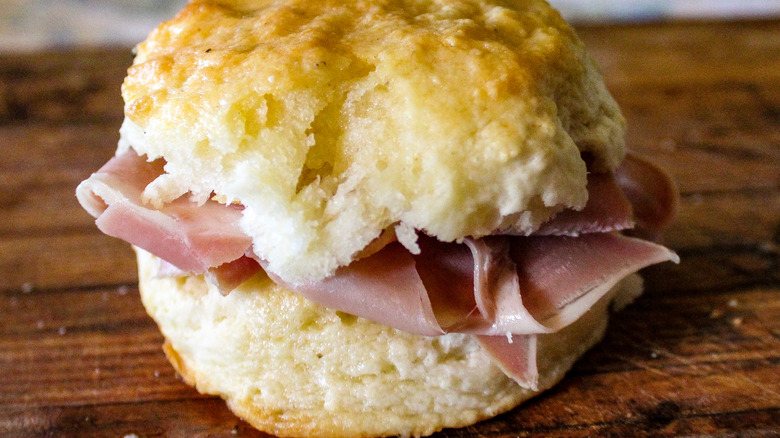Regional Sandwiches You Need To Try Before You Die
While Pb&J's, BLT's, and Bacon, Egg, and Cheese are the backbones of America, the extraordinary world of regional sandwiches are our bangles, weaving local history and culture with the creativity of the human palate. A great regional sandwich doesn't happen overnight. Each regional delicacy has a complicated history, spread in part through word of mouth. Some of these sandwiches are still served out of the very same hot dog stands they came from.
These sandwiches have been serving up working-class American citizens at the forefront of strikes, inside the factories, and scraping the bottom of the barrel along their way to recognition as local legends. From the lobster rolls of New England to the Hot Brown open faces of Louisville, these sandwiches make up a must-do culinary bucket list. Strike out on your own and discover the corners of the country, one sandwich at a time.
Philly Cheesesteak
When it comes to cheesesteaks and brotherly love, the passion runs deeper than the Cheez Whiz drips down your elbows. This culinary masterpiece traces its roots back to the 1930s when two brothers running a corner food stand got tired of hot dogs for lunch. Armed with meat scraps procured from the local butcher, they fired up the grill and unleashed a legend that still sizzles on the streets of Philadelphia today, marinating in its own delicious history. Surprisingly, the original recipe lacked a crucial ingredient: cheese. It wasn't until a store manager and notorious tippler named Cocky Joe Lorenza decided to dabble with provolone that the modern cheesesteak was born. Nowadays, you can find all sorts of cheese on steaks, as well as peppers, mushrooms, and hoagie fillings for an endless variety of Philly flavors.
The hot dog stand's success soon turned into a standalone restaurant known as Pat's King of Steaks. Across the street, Geno's emerged as another custodian of the cheesesteak crown. These two neighboring vendors are still the national representatives of the Philly Cheesesteak, and brotherly love is apparent in their rivalry. Pat's founders liken Geno's to the Krusty Krab's Chum Bucket, while Genos says Pat's is nothing more than a hot dog cart. For your first taste, head to the cheesesteak corner, where Pat's has 300 cans of Whiz waiting. While in line, decide if you want your sandwich "Whiz wit or wit-out." Whatever you do, don't walk up there and ask for Swiss cheese.
Muffuletta
The muffuletta is another stellar example of Italian immigrants bringing culinary traditions to a new world of flavor. The sandwich is named after the bread used in its making, a traditional Sicilian round loaf topped with sesame seeds. A muffuletta is built on Italian bread, incorporates Italian meats and cheeses, and was even created by Sicilian immigrants — yet the same style of sandwich does not exist in Italy. The muffuletta has international origins, but it was born, bred, and schmeared on the streets of New Orleans, one of the country's best sandwich stops.
The story goes like this: Italian laborers would stop in Central Grocery for lunch, enjoying a loaf of bread, meats, cheeses, and an olive salad, perhaps with a few sips of a full-bodied red. Grocery store proprietor Salvatore Lupo thought, why not throw all this deliciousness together? Presto — the muffuletta was born. Central Grocery is still owned by the Lupo family today, who stay slinging sandwiches as the undisputed champ of muffuletta. The store owes its success to a constant commitment to the process, continuing to slice meats in-house, using only locally baked handmade bread, and favoring the family's Italian Olive Salad recipe. Central grocers have also proven unafraid to grow with the times, working out a nationwide delivery system that ships authentic New Orleans muffuletta to couches around the country.
Cubano
If you're starting to notice a pattern in these sandwiches, you're not wrong. It can be hard to describe American food because, just like any of us who don't have Native American ancestry, it all came from somewhere else. The beauty of American regional cuisine is how the food has morphed and twisted from its early immigration into an entirely new creation. Or, as the authors of "The Cuban Sandwich: A History In Layers" overviewed, "Like all great food stories, the history of the Cuban Sandwich is a story of people and their migration toward freedom and prosperity and away from war and political oppression."
How can one sandwich have all that power? It's basically a glorified ham and cheese sandwich using specific ingredients: Cuban bread cut in half, buttered, and stuffed with pickles and pork. In Cuba, the Cubano was just a sandwich; it wasn't until Cuban immigrants began to settle and shape the mangroves of Southern Florida into little Havana that the legend of the regional sandwich, and spirited debates over the proper ingredients, began. The heart of modern Cuban sandwiches is split between two cities, Tampa and Miami, each claiming the Cuban as its own. But instead of taking sides, let's take a bite — or two. Miami's by-the-book approach and Tampa's infusion of Genoa salami add a twist worthy of spending the weekend sampling the best of both worlds.
French Dip
Before the French Dip was ever a stack of roast beef squished between a crispy baguette and caramelized onions with a side of jus, it was a slimming fashion feature woven into women's dresses and men's jackets. The sandwich was only born after the French dipped out of the land grab out West, and settlers began to spruce up the West Coast. It's as American as apple pie, but that's about the only thing everyone can agree on. Depending on who you ask, the sandwich originated accidentally in a Los Angeles sandwich shop, Philippe's. One version details a happy accident, with owner Philippe Mathieu accidentally dropping a sandwich roll into some pan juice and the customer enjoying it so much he came back for more. In another version, a customer asked shopowner and Mathieu to dip his roll in gravy. And in still yet another origin story, the sandwich originated in Cole's Pacific Electric Buffet in an attempt to soften the crispy French bread for customers with more sensitive gums.
Regardless of who invented the sandwich, Phillippe's and Cole's remain open today, continuing to ride the coattails of this delicious sandwich. At Philippe's, crispy baguettes take the plunge into a blend of yesterday's jus and drippings from 400-500 pounds of beef. Unfortunately for us, they do not continue to serve a pint of wine for a quarter to wash it all down. Over at Cole's, the roast beef sandwiches are served with the jus on the side alongside a plethora of drink options as the pub also operates as one of the oldest bars in L.A.
Po' Boy
Unlike some sandwiches with strict ingredient lists, you can turn almost anything into a Po' Boy. Shrimp is probably the most popular protein ingredient, but Louisiana chefs have stuffed bread full of catfish, hot sausage, roast beef, crab, oysters, and anything else caught up in the nets last weekend. Three things make a Po Boy: a unique French bread that's not quite a baguette, a typically fried protein, and, perhaps most importantly, eating them in New Orleans. Besides those key features, the sandwiches are often served with lettuce, tomatoes, a remoulade or mustard sauce, and a rich history that envelops this sandwich like the wafting scents of fresh bread.
New Orleans-based historians have spent over a decade tracking down the Po' Boy to settle once and for all where the sandwich got its stripes. It turns out this bread was baked into a good old-fashioned working-class revolution, earning its name during the 1929 streetcar strike. This was no simple protest — streetcars were being ripped off their tracks as locals united against taking a ride. New Orleans had seen ham and fried oyster sandwiches before the calamity, but it was two former conductors turned sandwich shop owners, the Martin brothers, who elevated a sandwich into an icon when they used them to feed the "poor boys" left jobless by the strike.
Fried Bologna Sandwich
A fried bologna sandwich with mayo and tomato is a Southern symbol of the good old days. Slathered in mustard, Duke's Mayo, or just cold and wet, a mystery meat sandwich on white bread symbolizes the days before nutrition labels. While the manufacturing process may not be the most appetizing topic, the sandwich is enjoying a revival lately, showing up alongside chips and a PBR as part of a recession special. Southern folks know what some quality time in the frying pan can do, but not everyone has been so lucky.
The entire country was once fed on bologna, especially in public schools, among working-class folks, and in jail cells — often cold and soggy at best. The sandwich was mainly associated with mass feeding on a budget and was consistently used in places where the mission was to feed as many people for as few dollars as possible. Nobody who was forced to eat a bologna cup school lunch would grow up dreaming of Oscar Mayer. But more and more chefs are taking the attention away from moldy prison bologna and towards the frying pan at grandma's house. Passionate southern cooks are recreating the flavors of their childhood and finally giving fried bologna the attention it deserves.
Lobster Roll
Lobster used to be to New England what shrimp is to Alabama. You could barbecue lobster, saute it, boil it, dey's uh, lobster-kabobs, the list goes on and on. While the crustacean is now considered a delicacy, they used to lounge on the beaches in piles and were gathered by hand along the shoreline. As lobster became a sought-after delicacy, sandwiches emerged as a favored choice among harvesters, making a quick and satisfying meal out of a few pieces of white bread, butter, and the day's unsold catch. The rolls have never shed their working-class appeal, here to help us all enjoy more lobster without taking out a loan. Even today, some of the greatest lobster roll specialists argue a drop of lemon or a spoonful of mayonnaise is the only seasoning this beautiful sandwich requires.
Fortunately, lobster sandwiches themselves did receive a facelift beyond the soggy white bread and transitioned to a more fitting vessel — the hot dog bun. The transition from bread to bun was facilitated by the owners of Perry's Restaurant in Milford, Connecticut, who made the sandwich at the request of a traveling liquor salesman. Later, white bread evolved into a roll, after realizing sliced bread just wouldn't cut it.
There are two modern schools of lobster rolls: Maine and Connecticut style. Maine rolls let cold meat mix with mayonnaise, while Connecticut keeps the ingredients to a minimum, serving up lobster meat hot and buttery.
Pimento Cheese Sandwich
Pimento cheese might have originated in the North, but it was welcomed home in the South, finding its place nestled beneath two slices of bread. The sandwich can be as simple as pimento cheese filling and bread, or you can get creative by adding diced jalapeños and bacon. The important thing is a spiced-up, peppery cream cheese blend, a beautiful combination of Northern creameries teaming up with sweet pimento peppers imported from Spain.
It's no coincidence that Georgia became the epicenter of the Pimento Cheese Sandwich. After cream cheese and pimento mixes caught on, local farmers began cultivating their own domestic pimentos in Georgia. The state soon became a significant sweet pepper producer, churning out millions of canned pimentos each year and feeding its workforce on pimento cheese sandwiches. While this regional delight doesn't have a specific restaurant to claim as its birthplace, it has gained fame for its association with the Master's golf tournament held in Augusta, Georgia. Depending on who you ask, the pimento cheese sandwich is as important to the Masters as the green jacket. Even as inflation claimed cold-cut sandwiches and beer prices at Augusta National, you can still buy a pimento cheese sandwich for $1.50. Its enduring presence at the tournament and the uproar when tournament runners changed the recipe has solidified its status as a cherished regional sandwich.
Italian Beef
While the rest of the world might know Chicago for its deep dish or hot dogs, Italian Beef Sandwiches are finally getting the recognition they deserve since the release of "The Bear" took us further into a commercial kitchen than ever before. The sandwich is the first dish seen in the show when the flawed central character tries to put his own spin on the Italian Beef sandwich. He soon found out that tinkering with traditional Italian beef is absolute blasphemy around those parts.
Behind each thinly sliced beef sandwich are decades of traditional cooking techniques and hours of simmering roast, not to mention a unique blend of Italian spices that marinates alongside. Real-life icon's like Al's Italian Beef take great pride in noting their recipes have not changed since they opened their doors in the late 1930s. While it's been simmering a long, long time, serving an Italian beef sandwich is as simple as three steps: scooping juicy beef onto a French loaf, a glorious plunge into the savory jus, and slathering on a thick layer of giardiniera. Behind that succulent sauce lies the key to ordering Italian beef like a local. For your first dip, you've got to go for a hot and wet sandwich, dripping in the fruits of the beef slow roast and seasoned just right.
Hot Brown
Many regional sandwiches have complicated origin stories, or at least several restaurants staking their claim as originators. Not the Hot Brown. This open-faced regional sandwich has long been a delicacy of Louisville's historic Brown Hotel, a downtown landmark serving the best Hot Browns in the world since 1926. Legend has it that the Hot Brown was born to satisfy late-night partygoers who craved something more enticing than scrambled eggs. The ingenious chefs at The Brown Hotel concocted a masterpiece that would soon become a beloved regional delicacy.
The munchie starts with a hot plate of Texas toast sans crust, loaded with turkey and tomatoes, and sent to the oven. Once adequately heated, the sandwich is coated with a Mornay sauce, Pecorino Romano cheese, and bacon before being returned to sizzle in the broiler. The Mornay sauce is the key to the operation, and only three people in the kitchen have it mastered. Every chef at the hotel works with the mentality to never mess with the Mornay, but they always dollop out a plate full of the good stuff. You won't have much chance of eating this sandwich without the help of a fork and knife, unless you've spent the day on the bourbon circuit.
Country ham biscuit
In Charlottesville, Virginia, you celebrate love and death with country ham. This delicacy is ubiquitous with weddings, funerals, church Sundays, tailgate Saturdays, and leftover Mondays, ready to fill all bellies for all occasions. Its prevalence in all walks of life earned the Country Ham Biscuit recognition as Charlottesville's signature dish after prominent local food experts spent months searching for what distinguishes them the most. They found the same thing you will — a ham biscuit on pretty much every corner. The biscuit is everywhere in Virginia, and it was an important tradition by debutants and the formerly enslaved folks of Freetown alike.
The universal acclaim has led to many variations, especially for a sandwich with all the essential ingredients written into the title. The most common topping is mustard, but myriad sweet and salty relishes, preserves, butters, and cheese have etched out a place on the table. Then there's the biscuit itself. The doughy, flaky buns come in small, large, and sandwich sizes. While they are traditionally made out of buttermilk, Virginia ham pairs just as well with sweet potato biscuits and dinner rolls. The only real rule for this sandwich is that you've got to make heaps of them.
